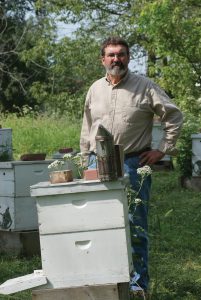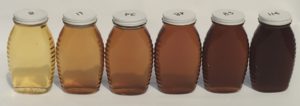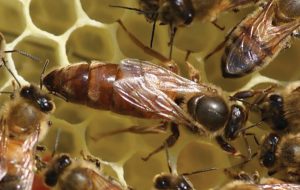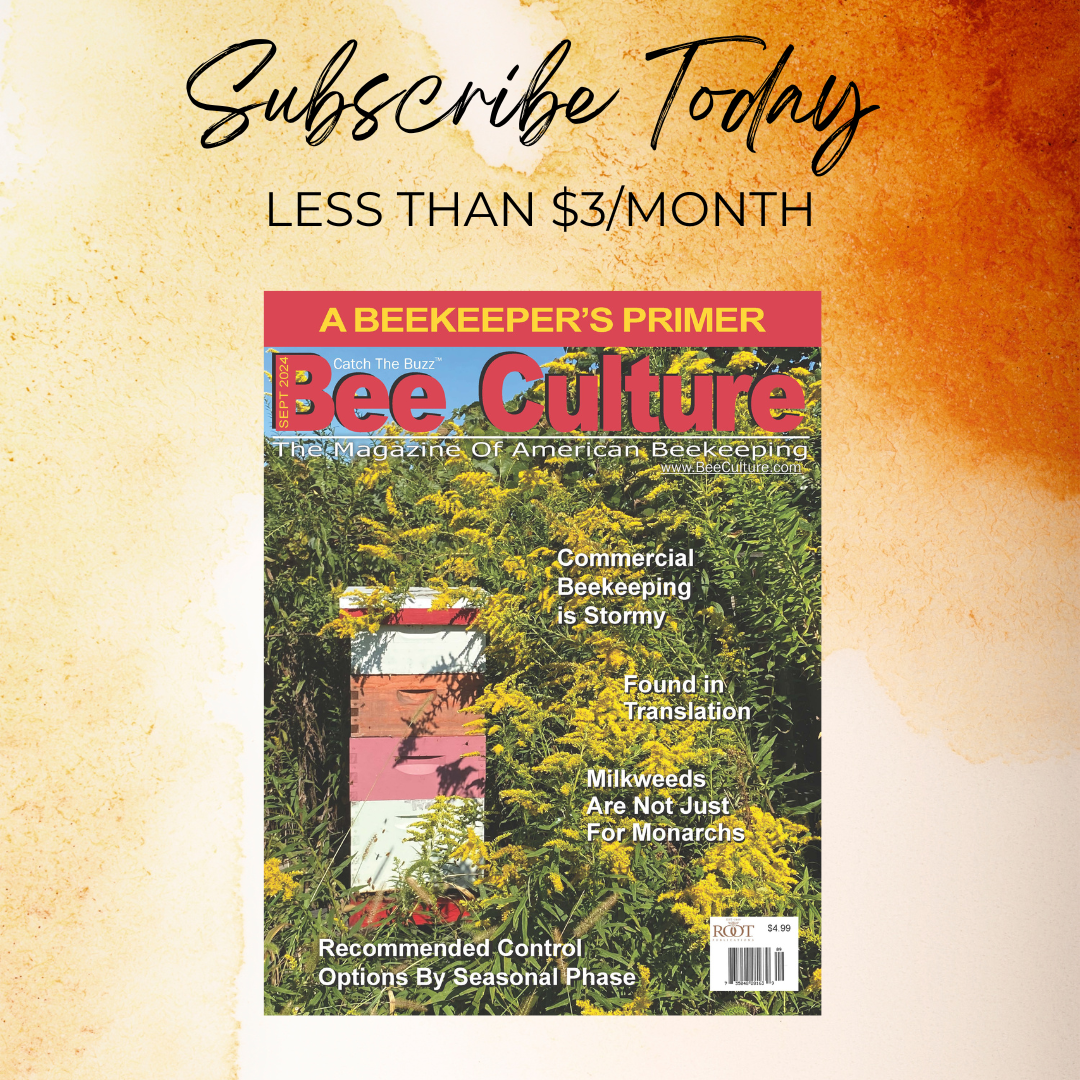 Got a Question?
Got a Question?
By: Phil Craft
A beekeeper in Missouri writes:
What is in the flowers’ nectar that makes honey light colored (typically Spring flowers) and other times (typically late Summer) that makes darker honey?
Phil replies:
When I was in college, more than a few years ago, my circle of friends included two young women named Rita and Shelly. Both were extremely health and diet conscious, exercising and eating lots of whole grains and raw vegetables. At one point, carrots became a major constituent of their diet. I’m certain it was a very healthy thing to eat, but they experienced a side effect from the beta carotene which gives pumpkins, apricots, sweet potatoes, and carrots their distinctive orange color. The skin of both girls acquired a decidedly tawny tint. They were disconcerted by the attention and comments they attracted, and perhaps also by the orange-hued reflections in their mirrors. It wasn’t long before they reduced their immoderate carrot consumption and their complexions returned to normal. The teasing from their friends took a little longer to fade away. As Rita and Shelly discovered first hand, you really are what you eat.
The color and flavor of honey is largely the result of what the bees consume, or in other words, the type of plant from which they gather the nectar to make the honey. That is quite correct as far as it goes, though geography, climate, age of the honey, and method of storage also have some effect. But, as your question indicates, that answer still leaves a lot unexplained. I was curious too, and did some research. The composition of honey is 96% water and various sugars. Other ingredients are responsible for only 4% of the volume, but almost all of the color, flavor, and healthful properties. These other ingredients number close to around 200, but until recently, they have not been given much study. A renewed interest in honey’s medicinal qualities, and efforts to assess environmental quality by analyzing trace pollutants in honey, have led to more research into its minor components in the last several years.
 The 4% consists of minerals and various chemical compounds, including amino acids, enzymes, polyphenols, acids, and carotenoids, all of which can affect color and taste. At least 27 minerals have been identified in honey, including calcium, iron, zinc, potassium, sodium, and magnesium. The most common is potassium, though other minerals predominate in some varietals. Minerals in food are sometimes referred to as its ash content, meaning the inorganic residue left after organic material has been removed through heating. Generally, dark honeys have a higher ash content than lighter ones, but there is more to honey color than minerals.
The 4% consists of minerals and various chemical compounds, including amino acids, enzymes, polyphenols, acids, and carotenoids, all of which can affect color and taste. At least 27 minerals have been identified in honey, including calcium, iron, zinc, potassium, sodium, and magnesium. The most common is potassium, though other minerals predominate in some varietals. Minerals in food are sometimes referred to as its ash content, meaning the inorganic residue left after organic material has been removed through heating. Generally, dark honeys have a higher ash content than lighter ones, but there is more to honey color than minerals.
Polyphenols are one of the reasons that honey is being studied more closely in recent years. They comprise a class of organic compounds sharing certain structural elements. There at least ten sub-categories of polyphenol compounds, two of which are found in honey: phenolic acids, and flavonoids. Each sub-category includes thousands of compounds. Phenolic acids are organic acids, meaning that they are acidic and include carbon in their chemical structure. They are similar to alcohol in structure, but have properties that result in their not being classified as alcohol. Phenol compounds are produced in nature, by plants and microorganisms in response to attack by insects or disease. Honeys with high phenolic content are darker in color. Flavonoids, the other group of polyphenol compounds found in honey, play a direct role in the yellow, red and blue colors in plant blooms, which aid pollinators in finding nectar sources. Some of them are found in all honeys, but are more concentrated in those of lighter hue. You have probably been reading and hearing a lot about flavonoids in the last few years. They are responsible for the antioxidant properties of foods such as fruit, tea, wine, and chocolate. Current scientific thinking is that antioxidants may play a role in preventing conditions as diverse as heart disease and cancer. Hence some of the research into the components and properties of honey.
Another class of antioxidants, unrelated to polyphenols but which are also found in honey, is carotenoids. These are organic pigments found in plants, where they influence color in the yellow, orange, and even red spectrums. They appear in higher concentrations in light honey, and are probably partly responsible for amber and light amber shades. The most well known carotenoid is beta carotene – remember Rita and Shelly? They had the right idea. People who eat lots of fruits and vegetables and other foods high in antioxidants tend to be healthier and suffer less from chronic illnesses. But maybe they should have eaten fewer carrots and consumed more honey instead!
A beekeeper in Ohio writes:
In an earlier column you said that the European honey bee is the only honey bee in this country but I keep reading and hearing about Italians and Russians and Carniolans. Aren’t these different kinds of bees that are here? I am a new beekeeper and I am totally confused. Can you help?
Phil replies:
It’s a confusing subject, in part because taxonomists (biologists who classify animals) aren’t always in agreement. I personally classify all taxonomists into two subspecies: the splitters and the lumpers. The splitters tend to subdivide groups of animals into separate species based on fairly minor differences; the lumpers place them into larger, more diverse groups under one species name. When a group of animals lives and breeds in isolation (typically confined by a geographic barrier, such as a mountain range, desert, or ocean) through many generations, it develops distinct physical characteristics and genetic differences which distinguish it from close relatives outside the group. Determining at what point those differences are significant enough to declare the existence of a new species or subspecies is a judgment call, and therein lies the ambiguity. Although classification is subjective, and non-scientists sometimes muddy the waters even further by stirring in non-scientific names or misusing scientific ones, I will try to bring as much clarity to the topic as I can.
European honey bee: Apidae (Family) / Apis (Genus) / Mellifera (Species)
All bees belong to the family Apidae which includes bumble bees, carpenter bees, orchid bees, cuckoo bees, and honey bees. Honey bees are members of the genus Apis within the Apidae family. Depending on who is doing the classifying, and when, the Apis genus is made up of five to eight species, all but one native to Asia. The lone exception is the European honey bee, Apis mellifera, native to the continents of Europe and Africa. Though no honey bees are indigenous to the Americas, A. mellifera, which was brought here by European settlers, is the one I often refer to as “our” honey bee. There are 28 recognized subspecies within A. melifera. It might seem surprising that taxonomists can be specific about the number of subspecies within Apis melifera, yet disagree on how many Apis species exist. It all boils down to money. Honey bees are the most studied insects in the world, but not just because they are such fascinating little creatures. It’s their value as pollinators and honey producers which justifies all the research dollars lavished upon them. Asian species, on the other hand, have much less economic value. Some are relatively poor honey producers, and others nest outdoors and are not adaptable to being managed in man made hives at all. Perhaps due to this reduced research attention, the Asian bees are less well understood and their classification more subjective, which is the reason for the lack of consensus on the number of Asian species.
 The subspecies of honey bees are sometimes referred to as races, but that is an archaic term, and I prefer to say subspecies. The first to be introduced to North America by colonists in the early 17th century were German, or Northern European, dark bees, A. mellifera mellifera. (Mellifera is the name for both the species and subspecies, appropriately enough since “mellifera” means honey bearing and these bees are doubly good producers.) The German bee was, and still is, known for its defensive behavior, and is said to be susceptible to certain diseases, including American foulbrood. As other subspecies of bees became available through importation, the dark bee faded in popularity and was not maintained by breeders here. Interestingly, though, there are widespread reports, likely true, that remnant populations of this bee still exist in the Appalachian Mountains and elsewhere in the east, as feral colonies in trees. While I was Kentucky State Apiarist, beekeepers in the eastern Kentucky mountains often told me of catching swarms of little black bees as mean as snakes. That characterization may be unfair, as I find snakes pretty well behaved unless provoked. I’ve never been chased by a snake, but I have had honey bees chase me home, bent on stinging me at every step. The beekeepers, though, seemed willing to put up with the grumpy behavior after they saw their first honey crop come in.
The subspecies of honey bees are sometimes referred to as races, but that is an archaic term, and I prefer to say subspecies. The first to be introduced to North America by colonists in the early 17th century were German, or Northern European, dark bees, A. mellifera mellifera. (Mellifera is the name for both the species and subspecies, appropriately enough since “mellifera” means honey bearing and these bees are doubly good producers.) The German bee was, and still is, known for its defensive behavior, and is said to be susceptible to certain diseases, including American foulbrood. As other subspecies of bees became available through importation, the dark bee faded in popularity and was not maintained by breeders here. Interestingly, though, there are widespread reports, likely true, that remnant populations of this bee still exist in the Appalachian Mountains and elsewhere in the east, as feral colonies in trees. While I was Kentucky State Apiarist, beekeepers in the eastern Kentucky mountains often told me of catching swarms of little black bees as mean as snakes. That characterization may be unfair, as I find snakes pretty well behaved unless provoked. I’ve never been chased by a snake, but I have had honey bees chase me home, bent on stinging me at every step. The beekeepers, though, seemed willing to put up with the grumpy behavior after they saw their first honey crop come in.
The mid-nineteenth century saw a revolution in the form of hives with removable frames, and a consequent expansion of American beekeeping. Along with the introduction of innovative equipment, such as smokers and extractors, came the importation of new subspecies of bees, this time by bringing in queens instead of whole colonies. The first to enter the U.S. marketplace, and the hives of beekeepers, were the Italians, A. m. ligustica, in 1859. Italian bees, with their gentler disposition, and attractive yellow coloring quickly became the favorites of American beekeepers. Others soon followed, including the Carniolans, A. m. carnica. They were brought to our shores in 1887 from the area of Romania, Hungry, and the former Yugoslavia (now Serbia and Bosnia.) Carniolans never became quite as popular as their Italian cousins, but their habit of cutting back on brood rearing when nectar flows ebbed, allowed them to overwinter well in cooler climates. They continue to have a following today, and are this writer’s choice when buying new queens. The Caucasians, A. m. caucascia, were first imported here in the 1880’s, from their home range of the Caucasus Mountains in the Republic of Georgia, near the Black Sea. They were never highly popular, but are still available from a few queen producers, valued for their very gentle behavior. They are also known for their copious production of propolis, and their slow winter buildup.
Some of the late eighteenth century introductions never caught on at all, and were not maintained by breeders. One was the Punic bee, from North Africa, A. m. intermissa. The subspecies of Africa all exhibit a tendency to walk on the defensive side of the street, and this bee is not an exception. Another dud, in terms of finding a niche in the new world, also due to its cranky behavior, was A. m. Cypria. Its original range was the Island of Cyprus, in the Mediterranean Sea. The Egyptian honey bee, A. m. lamarckii, whose home range can be deduced from its common name, was brought here in 1866. Its bad behavior was a factor in its not catching on, but I have also read that it did not acclimate to modern beekeeping equipment. The Egyptian honey bees were maintained by beekeepers in Egypt for thousands of years. There they were kept in skeps and moved on the Nile in barges, where they may have been used in the earliest migratory beekeeping operations.
The trial and error approach of bringing over various subspecies of honey bees to see which ones would stick, so to speak, ended with the 1922 Honeybee Act. The act, an attempt to prevent the introduction of tracheal mites, prohibited further importations of honey bees into the United States. The quarantine worked until 1984, when a mite apparently smuggled itself across the Mexican border inside an infested honey bee. As a result of the ban, most subspecies of honey bees bred in the U.S. are genetically descended from stock introduced in the eighteenth and early nineteenth centuries. Although they may not quite be mutts, as a friend of mine once described them, all of our honey bees have a mixed lineage – even when breeders carefully select traits in an attempt to keep the original subspecies as pure as possible.
Recent events have introduced new honey bee genetics within our borders for the first time in decades. The best known, unfortunate, and unplanned instance was the incursion of the Africanized bee, a hybrid of A.m. scutullata, the highly defensive subspecies from South Africa. After escaping from a lab in South America, Africanized bees, like tracheal mites, slipped across our southern border sometime prior to their detection in Texas in 1990. (Though perhaps I’m dating myself by referring to an event of 25 years ago as recent.) More recently, and much more positive for bees and beekeepers, the government has approved the importation of honey bee semen by U.S. researchers, specifically semen from Carniolan and Caucasian bees. These introductions promise to increase genetic diversity among stocks here, and will, I hope, result in the reemergence of Caucasian honey bees as a choice for beekeepers. Another very successful effort has been the importation and introduction of honey bees from Western Russia, as part of the varroa resistant Russian honey bee program at the U.S.D.A. Baton Rouge lab. However, Russian honey bees are not a subspecies, but are a variety or line of honey bees, and that is another topic, for another column.






